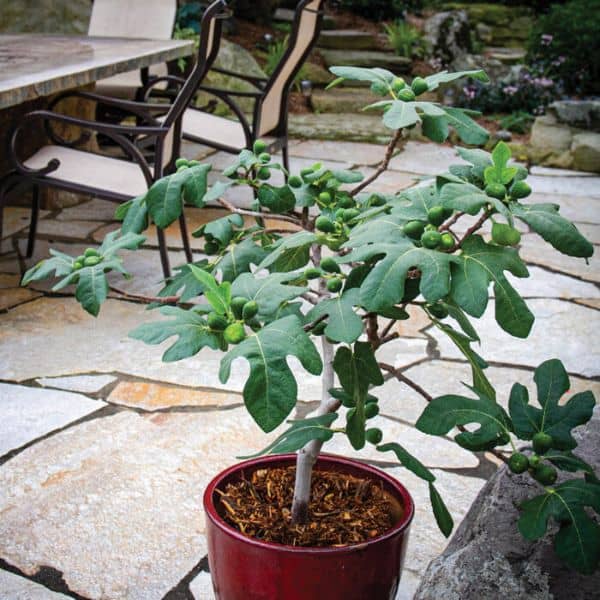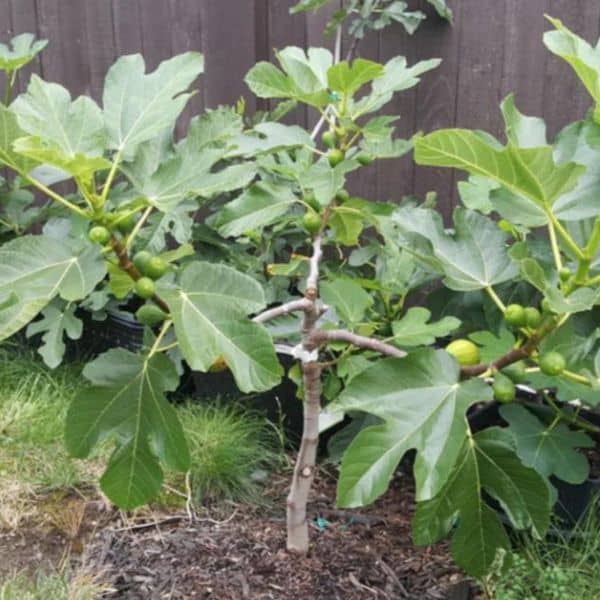Homegrown fruit has become increasingly popular, and one of the most popular types among gardeners is the Little Miss Figgy Fig tree. This dwarf big tree is a great choice for a variety of environments since it is lush and compact and as this plant doesn’t get very tall, it works well for small gardens, pots, or terraces.
Here, we will discuss all the necessary methods for planting, caring for, and troubleshooting common problems with a Little Miss Figgy fig tree.
Little Miss Figgy is a beautiful dwarf fig type that is known for its small height and prolific fruit production. It is ideal for urban environments or small locations where larger fig trees would be unsuitable as they grow to a maximum height and width of around 4-6 feet. Its deeply broad, dark green leaves give it a lush, tropical appearence.
Planting Litle Miss Figgy
Correct Location for Your Plant
For optimal growth, select a sunny spot with well-draining soil for your Little Miss Figgy fig tree, as this plant thrives in full sunlight and can adapt to a variety of soil types as long as they provide good drainage.
Soil Preparation
Miss Figgy prefers well-drained soil rich in organic matter i.e. pH of 6.0-7.0 slightly acidic to neutral is best. To improve fertility and drainage, amend your natural soil by adding garden soil and compost.
So, where and how should you plant Miss Figgy? Well, this plant loves the sun, so choose a location that receives plenty of direct sunlight each day.

In Container
- Choose a container that is at least 18 to 24 inches in size, and has drainage holes.
- Add high-quality potting mix to the pot.
- After planting the plant in the center, cover it completely with soil and water it.
In Ground
- For ground planting, dig a hole that is the same depth and twice as broad as the root ball.
- If needed, amend the soil with compost.
- As you plant the tree in the hole, make sure the top of the root touches the soil.
- Water well, backfill and gently tap the soil.
Watering
When it comes to watering, keep things simple but consistent, deep watering once a week will do during the growth season. Particularly during dry spells to maintain consistently moist soil, on the other side, for trees in containers, increased frequency of watering may be necessary.
Pruning-Yes or No?
Miss Figgy requires regular pruning to stay healthy and in good shape. Late winter is the best time to prune to keep the perfect shape and to get rid of any dead or congested branches. When comparing Litle Miss Figgy to bigger fig types, less pruning is needed. Regular pruning promotes vigorous plant growth leading to increased crop yields, and will ensure the neatness of your Little Miss Figgy besides healthy blossoming.
Fertilizer
Apply a balanced, slow-release fertilizer in early spring and mid-summer to support robust growth and fruit. Established trees typically do not require frequent fertilization unless they are grown in containers, which may need fertilizing three to four times a year due to nutrient leaching.
How to propagate Little Miss Figgy Fig
If you are looking to propagate this beautiful fig plant, then here are some methods:
- In late winter, take cuttings from hardwood. Until new growth appears, root them in a moist, well-draining mix.
- A low branch can be dipped to the ground, and covered with the soil, and after a few months, you will see the baby plant will start to take root and can be split off from its original leaf.
- Keep the pot in a warm, bright location until new growth appears.

Overwintering your Fig Tree
Protecting in-ground plants, fill the base of your fig tree with a thick layer of mulch if you live in a cooler area.
Caring for Container plants, Potted figs should be moved to a protected area with temperatures above freezing, such as a garage or basement.
Common Problems and Solutions
Pests and Disease
Aphids, worms, and insets are common pests that harm Little Miss Figgy, prompt treatment is necessary for strong fruit production. Enhancing air circulation, minimizing overhead watering, and applying fungicides on time can help manage fungal diseases like fig rust. Furthermore, maintaining orchard floors clean and trimming trees properly helps stop insect and disease problems in your plant.
Overwatering and Underwatering
For Little Miss Figy, underwatering and overwatering are common problems. Drooping leaves and dry soils are signs of underwatering, especially if water goes off to the side instead of reaching the roots of the plant. On the other hand, overwatering causes root rot, yellowing leaves, and slow growth due to oxygen deprivation in the soil.
In sum, Moderate watering is essential to maintaining the healthy growth of the plant, also make sure the soil drains well, and only water when the top inch feels dry.
You may like to read, Lemon Lime Nandina Plant Growth And Care Guide!
FAQs
1. When does little Miss Figgy produce fruit?
Late summer to early fall is when Little Miss Figgy usually produces the fruit, but it also depends on climate conditions.
2. What does Little Miss Figgy taste like?
Little Miss Figgy fruits are edible and have a delicious taste, these figs have a taste of berry and honey. They are great when eaten raw, and baked.
3. How hardy is little Miss Figgy?
Miss Figgy is moderately hardy, in colder regions, it requires winter protection, such as mulching around the base or moving indoor container plans to avoid frost damage. For best fruit development, they need to be in full sun in a warm location.
4. How often should I water Little Miss Figgy?
During the growth season, give plants a deep watering once a week whereas in hot, dry areas, your plants require more watering. If you have planted it in a container, it could require more regular watering.
